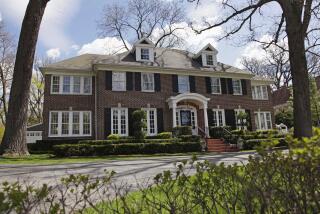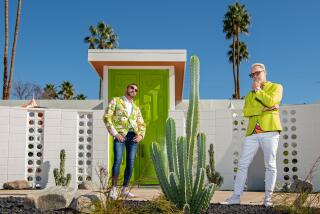Intrepid iconoclasts create soulful homes in the new Apple TV+ docu-series āHomeā
In a bit of fated synchronicity, Apple TV+ās docu-series āHomeā premieres just as everyoneās been spending a lot more time there. The nine-episode lineup, a South by Southwest Film Festival selection, debuts in its entirety April 17.
The short take: The series is exceptional.
Surprisingly varied as well as profound, the half-hour segments document nine international iconoclasts and their bold domestic visions. What might have been just another āOMGā take on outrĆ© luxury digs, or a breezy riff on ways to make homes sustainable, is actually a deep dive into the very meaning of āhome.ā
Donāt be surprised if the series transforms the way you consider your own residence ā whether you inhabit a six-bedroom manse with jetliner views or a 344-square-foot studio apartment.
In fact, letās start with that 344-square-foot flat.
You might already be familiar with architect Gary Changās tiny Hong Kong apartment termed the āDomestic Transformer,ā given its widespread news coverage. Toying with those 344 square feet as one would a Rubikās Cube, Chang has devised 24 room layouts and āendless permutations,ā using sliding wall units and a design genius reminiscent of origami or a Swiss Army knife.
āHomeā takes you inside the protean wonder.
A mere push on a wall reveals a kitchen with a stocked minibar ā or a full bath, walk-in closet, CEO-worthy desk, home cinema ā¦
The episode examines the very perception of space ā and Chang commands it like a shaman, inspired by the manic pulse that is Hong Kong, where 7.4 million people share limited resources.
āAll of these homes stem from some kind of problem, limit or challenge that results in a series of decisions to solve that problem,ā said āHomeā executive producer Doug Pray, who directed episodes based in Austin, Texas, and Sikhall, Sweden.
Rejuvenation is another recurrent theme among all the intrepid mavericks, whose personal journeys are also explored.
An Austin science fiction writer removes a toxic pipeline, using the gash in the land as a footprint for a partly buried home, its roof a restored prairie speckled with wildflowers.
A Toronto-born woman raised in Bali moves to New York City, where she designs fashion for Donna Karan, only to return to Bali. There she becomes a kind of bamboo whisperer, creating fanciful, Seussian homes out of the fast-growing plant.
In Sweden, engineer Andres Solvarm builds a log cabin and encases it in a lush greenhouse, creating a sustainable bio-environment. Itās like living in northern Italy year-round, while surrounded by brutal Nordic winters.
āYouāre just overwhelmed with how itās filled with oxygen and the lush feeling of life ā the equivalent of being in a deep forest,ā Pray said of the leafy home, part of the āNaturhus movementā created by Swede Bengt Warne.
In Chicago, the indefatigable Theaster Gates rejuvenates a decaying South Side neighborhood, its centerpiece the restored 1923 Stony Island Bank, now a space for art exhibitions and archives. Thereās deep grace in the way Gates enlivens rather than gentrifies his surroundings as he identifies value (his ālove investmentā) in abandoned objects, buildings and, indeed, his community.
As Gates terms it, he reveals the ālife within things.ā
āIf thereās a takeaway from the series, itās that the solution is right in front of you,ā said Pray, who lives in Mount Washington.
Thatās exactly the genius behind āHomeā ā all nine domestic dreamers have their feet solidly on the ground and, like wizards, seem to conjure a kind of clear beauty from empty air.
Case in point: design visionary Tony Duquette, whose oddball-opulent aesthetic graced the homes of the Duchess of Windsor and J. Paul Getty. Among other creations realized before his death in 1999, Duquette built Malibuās mystical āXanabu,ā a kind of bohemian Shangri-La. Now stewarded by architect David Hertz and his wife, Laura Doss-Hertz, the 42-acre property featured on āHomeā includes an East Asian-influenced village built from such repurposed finds as Duquetteās movie sets.
All of the seriesā pioneer creators have developed and promoted their concepts in hopes of widespread adoption. Witness the Mexico segment, in which innovators extrude two 3-D-printed homes for the āworldās first 3-D communityā of 50 residences located in poverty-crushed Nacajuca, Tabasco.
The revelatory light that passes over the familiesā faces as they view their new homes ā they previously lived in leaky, corrugated-metal shacks ā is priceless.
Rounding out the lineup are Indiaās artisan-built āWall Houseā and Maineās āSoot House,ā which employs the ancient Japanese wood-burning technique yakisugi. The family-centric Maine episode arguably lends the series its most deeply felt moments. Scenes of the coupleās sons being born in their handcrafted home, set deep in the forest, are exquisite.
Such payoffs from emotional investments are well known by anyone who infuses their home with care. Chang, the Hong Kong architect, summed it up: āNot only did I transform my home ā it transformed me.ā
Newsletter
More to Read
Sign up for Essential California
The most important California stories and recommendations in your inbox every morning.
You may occasionally receive promotional content from the Los Angeles Times.






